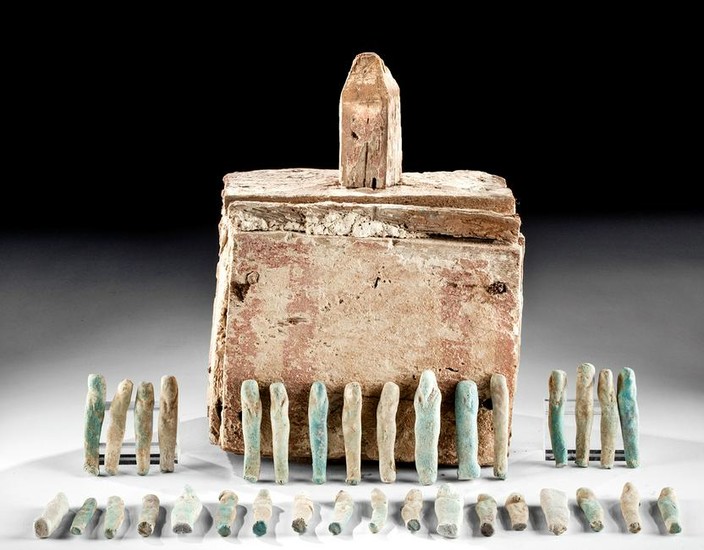Rare Egyptian Wood Ushabti Box w/ 98 Faience Ushabti
Egypt, Late Dynastic to Ptolemaic period, ca. 664 to 30 BCE. A beautiful box meant to contain dozens of petite faience figures. Constructed from several carved rectangular wooden slats that are secured with wooden dowels, the box has a hollow body atop a bulging base, tall walls, and a removable lid with an obelisk-shaped handle. The exterior of the box and lid are covered with white gesso and painted with stripes of russet-red pigment. Included with the box are dozens of mold-formed ushabti figures, some of which are covered in turquoise-hued glaze, with 71 intact, 13 partially intact, 14 fragmentary figures, and five petite fragments. Size (box): 5.125" L x 7.125" W x 9.5" H (13 cm x 18.1 cm x 24.1 cm); (largest shabti): 2.9" H (7.4 cm)
Ushabti dolls are figures shaped like adult male or female mummies wearing traditional Egyptian headdresses. The ancient Egyptians believed that, after they died, their spirits would have to work in the "Field of Reeds" owned by Osiris, the god of the underworld. As a result, they are frequently depicted with arms crossed, typically holding picks and hoes, with baskets on their backs. This meant that the task of agricultural labor was required by all members of society, from workers and scribes to aristocrats and even pharaohs. The wealthier nobility in Egyptian society were able to have ushabti made of faience, though wood was a more economical option for members of lower classes.
Provenance: private J.H. collection, Beaverton, Oregon, USA, acquired in December 2018; ex-Arte Primitivo, New York, New York, USA, auction #91 (December, 2018, lot 565); ex-private New York, New York, USA collection, brought to USA prior to 1948, to present owner by descent
All items legal to buy/sell under U.S. Statute covering cultural patrimony Code 2600, CHAPTER 14, and are guaranteed to be as described or your money back.
A Certificate of Authenticity will accompany all winning bids.
We ship worldwide to most countries and handle all shipping in-house for your convenience.
#151237 Dimensions: Condition Report: Box has minor losses to base, walls, lid, and handle, with fading and chipping to original painted gesso, and light encrustations. Thirteen ushabti figures have chips to feet and/or lower bodies, with fourteen being fragmentary but with most original pieces remaining. Nice earthen deposits throughout.
View it on
Sale price
Estimate
Time, Location
Auction House
Egypt, Late Dynastic to Ptolemaic period, ca. 664 to 30 BCE. A beautiful box meant to contain dozens of petite faience figures. Constructed from several carved rectangular wooden slats that are secured with wooden dowels, the box has a hollow body atop a bulging base, tall walls, and a removable lid with an obelisk-shaped handle. The exterior of the box and lid are covered with white gesso and painted with stripes of russet-red pigment. Included with the box are dozens of mold-formed ushabti figures, some of which are covered in turquoise-hued glaze, with 71 intact, 13 partially intact, 14 fragmentary figures, and five petite fragments. Size (box): 5.125" L x 7.125" W x 9.5" H (13 cm x 18.1 cm x 24.1 cm); (largest shabti): 2.9" H (7.4 cm)
Ushabti dolls are figures shaped like adult male or female mummies wearing traditional Egyptian headdresses. The ancient Egyptians believed that, after they died, their spirits would have to work in the "Field of Reeds" owned by Osiris, the god of the underworld. As a result, they are frequently depicted with arms crossed, typically holding picks and hoes, with baskets on their backs. This meant that the task of agricultural labor was required by all members of society, from workers and scribes to aristocrats and even pharaohs. The wealthier nobility in Egyptian society were able to have ushabti made of faience, though wood was a more economical option for members of lower classes.
Provenance: private J.H. collection, Beaverton, Oregon, USA, acquired in December 2018; ex-Arte Primitivo, New York, New York, USA, auction #91 (December, 2018, lot 565); ex-private New York, New York, USA collection, brought to USA prior to 1948, to present owner by descent
All items legal to buy/sell under U.S. Statute covering cultural patrimony Code 2600, CHAPTER 14, and are guaranteed to be as described or your money back.
A Certificate of Authenticity will accompany all winning bids.
We ship worldwide to most countries and handle all shipping in-house for your convenience.
#151237 Dimensions: Condition Report: Box has minor losses to base, walls, lid, and handle, with fading and chipping to original painted gesso, and light encrustations. Thirteen ushabti figures have chips to feet and/or lower bodies, with fourteen being fragmentary but with most original pieces remaining. Nice earthen deposits throughout.



